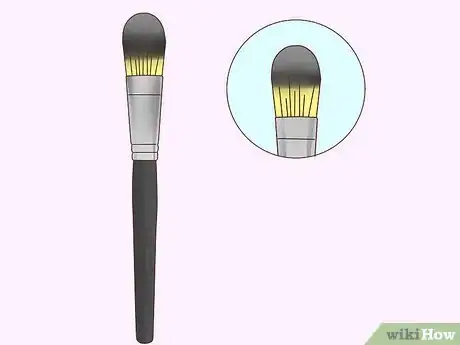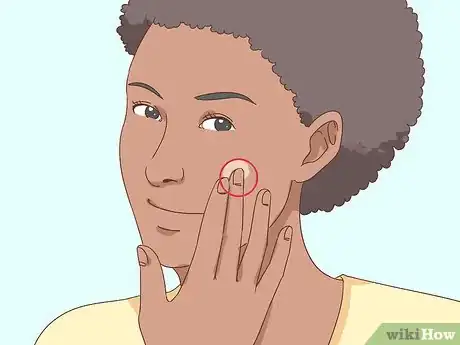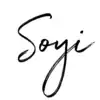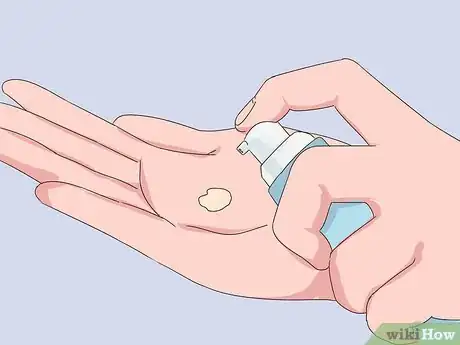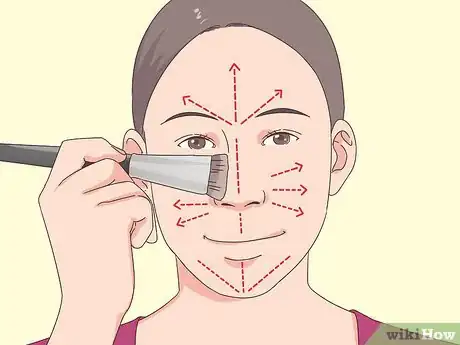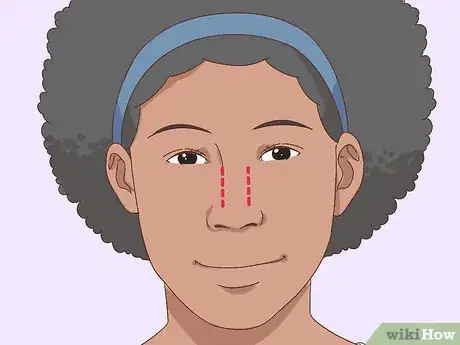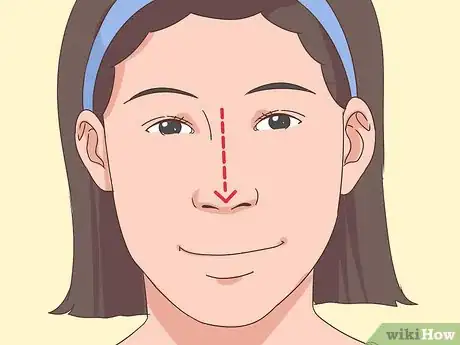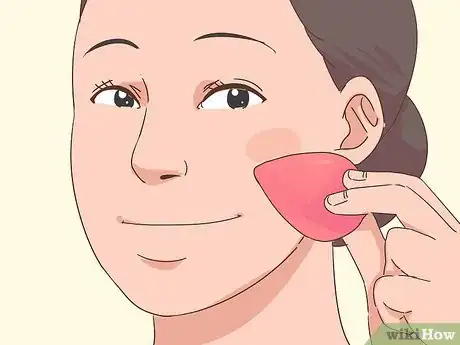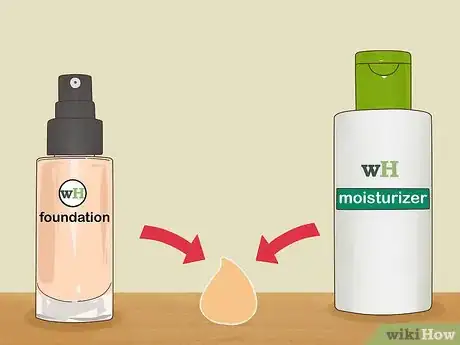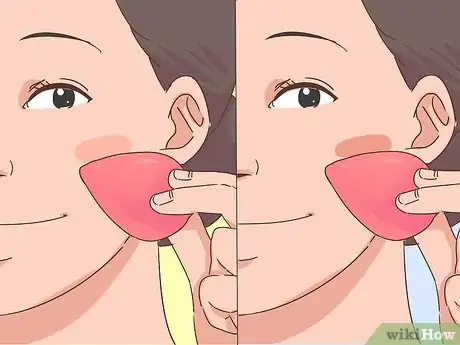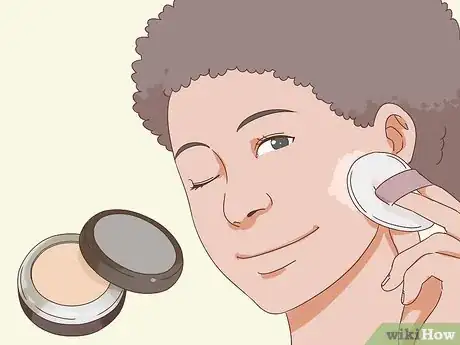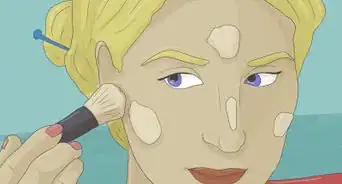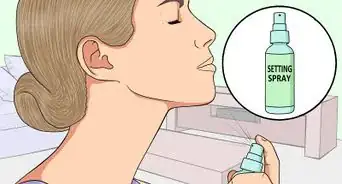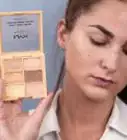X
This article was co-authored by Daniel Vann. Daniel Vann is the Creative Director for Daredevil Cosmetics, a makeup studio in the Seattle Area. He has been working in the cosmetics industry for over 15 years and is currently a licensed aesthetician and makeup educator.
This article has been viewed 17,903 times.
Cream foundation is excellent for getting moderate to heavy coverage. Because of the level of coverage, it is especially useful for covering up fine lines, wrinkles, and blemishes. You have a few different options for applying this foundation, including a tapered brush, beauty sponge, or your fingertips. Make sure to use good technique and consider the level of coverage you want as well.
Steps
Method 1
Method 1 of 3:
Choosing an Applicator Tool
-
1Use a tapered foundation brush to get even, full-face coverage. A tapered brush is one of the best tools for applying cream foundation because it makes it easier to get even coverage. Using a brush to apply cream foundation may also make it easier to get even coverage in areas like your eyelids, around your nostrils, and along your hairline.[1]
- Dab a small amount of cream foundation on the brush and then begin spreading it over your face using short strokes.
- Keep going until you have the desired coverage.
-
2Use a beauty blender sponge for sheer, buildable coverage. Beauty sponges are also excellent tools for getting even coverage with your cream foundation. These sponges are dense and curved with a pointed tip on the end. You can use the curved part of the sponge for larger areas of your face and the pointed part of the sponge for small areas, such as your eyelids and the areas around your lips.[2]
- Dab a small amount of foundation on the sponge and then use short strokes to get even coverage.
- Smooth the sponge over your skin until you get the coverage you want.
Advertisement -
3Use your fingers for controlled spot application. If you don’t have any special tools for applying makeup, then you can also use your fingers to apply the cream foundation. Dab a small amount of cream foundation onto a few of your fingertips and then begin applying the foundation to your face.[3]
- Use your fingertips to blend the foundation evenly over your face until you are happy with the coverage.
Advertisement
Method 2
Method 2 of 3:
Using Good Technique
-
1Wash and moisturize your face. Before you apply foundation, make sure to wash your face thoroughly and apply moisturizer.[4] This helps the foundation go on smoothly and it may also improve your results. Follow your usual skin care routine to prep your skin.[5]
- You may also want to apply a thin layer of face primer so your foundation goes on smoother and lasts longer.[6]
-
2Warm up a bit of foundation in your hand. Warming the foundation in the palm of your hand helps it to go on smoothly. Try applying a small amount into the palm or back of your hand and then dab into it with your brush, sponge, or fingertips.[7]
- Avoid dipping your fingers directly into your foundation so you don't get germs in it. Instead, use a clean spatula to scoop some foundation out of the container and place it on a palette.[8]
-
3Start from the center of your face to get even coverage. Applying foundation from the center of your face going outwards ensures even coverage. Use your tool or fingertips to begin applying the foundation.
-
4Apply some cream foundation along the sides of your nose. Apply a dab of cream foundation on both sides of your nose, and then spread the foundation out towards the edges of your face to cover your cheeks. Spreading the foundation out from the sides of your nose will help you get even coverage on your cheeks.
-
5Dab some foundation above your nose. Next, apply foundation just above your nose and spread it out over your forehead. Dab some foundation above your nose and then sweep the foundation up and out towards the edges of your face. Keep going until you have covered your entire forehead evenly.
-
6Fill in the other areas of your face with foundation. Dab some foundation onto any areas of your face where you have not yet applied foundation, like your chin. Then, begin spreading the foundation out and away from the center of your face to cover these areas evenly.
-
7Blend well. No matter how you apply the cream foundation, make sure to blend it well. Go over areas where you applied the foundation multiple times to ensure that the foundation is well blended.[9] Then, check in the mirror for any splotchy or patchy areas and blend these areas as needed.
- A beauty sponge or your fingers are both great for blending the cream foundation.
Advertisement
Method 3
Method 3 of 3:
Getting Your Ideal Coverage
-
1Blend with moisturizer for light coverage. If you don’t want a heavy layer of foundation on your face, then try mixing a small amount of your foundation with an equal amount of moisturizer. Blend these together and then apply the foundation/moisturizer mixture to your face.[10]
-
2Apply in thin layers to build up coverage. If you are unsure about how much foundation you want to apply, then try applying your foundation in layers. Start with just a light layer of cream foundation and then add another layer or two if the coverage is not heavy enough for you.[11]
-
3Add foundation to areas that require more coverage. You can also apply a thin layer for all over coverage and then go back in and apply more cream foundation to areas that need more coverage. For example, if you have any redness, dark circles, or blemishes, then you could apply a little extra cream foundation to these areas.[12]
-
4Use powder foundation for additional matte coverage (optional). Cream foundation provides moderate to full coverage depending on how you apply it, so you may not need to use a powder foundation at all. However, if desired, you can apply a layer of powder foundation after you finish applying your cream foundation. Use a brush to sweep the powder foundation over your skin.[13]
- Powder foundation can help to set the cream foundation and provide matte coverage as well.
Advertisement
Expert Q&A
Did you know you can get expert answers for this article?
Unlock expert answers by supporting wikiHow
-
QuestionIs cream foundation better or powder?
 Daniel VannDaniel Vann is the Creative Director for Daredevil Cosmetics, a makeup studio in the Seattle Area. He has been working in the cosmetics industry for over 15 years and is currently a licensed aesthetician and makeup educator.
Daniel VannDaniel Vann is the Creative Director for Daredevil Cosmetics, a makeup studio in the Seattle Area. He has been working in the cosmetics industry for over 15 years and is currently a licensed aesthetician and makeup educator.
Licensed Aesthetician They both get the job done, but I tend to think of creams as a slightly better option. It's very easy to use powder, but it can look kind of poor in photos. There's also an issue with accidentally adding too many layers of powder, which can build up on your skin if you're applying powders every day. There are also a lot of creams out there, so you have many more options with that.
They both get the job done, but I tend to think of creams as a slightly better option. It's very easy to use powder, but it can look kind of poor in photos. There's also an issue with accidentally adding too many layers of powder, which can build up on your skin if you're applying powders every day. There are also a lot of creams out there, so you have many more options with that. -
QuestionHow long is foundation good for before it expires?
 Daniel VannDaniel Vann is the Creative Director for Daredevil Cosmetics, a makeup studio in the Seattle Area. He has been working in the cosmetics industry for over 15 years and is currently a licensed aesthetician and makeup educator.
Daniel VannDaniel Vann is the Creative Director for Daredevil Cosmetics, a makeup studio in the Seattle Area. He has been working in the cosmetics industry for over 15 years and is currently a licensed aesthetician and makeup educator.
Licensed Aesthetician
-
QuestionWhich type of foundation looks the most natural?
 Daniel VannDaniel Vann is the Creative Director for Daredevil Cosmetics, a makeup studio in the Seattle Area. He has been working in the cosmetics industry for over 15 years and is currently a licensed aesthetician and makeup educator.
Daniel VannDaniel Vann is the Creative Director for Daredevil Cosmetics, a makeup studio in the Seattle Area. He has been working in the cosmetics industry for over 15 years and is currently a licensed aesthetician and makeup educator.
Licensed Aesthetician
Advertisement
Things You’ll Need
- A tapered brush, makeup sponge, or your fingertips
- Facial cleanser
- Moisturizer
- Cream foundation
- Powder foundation (optional)
References
- ↑ https://www.makeup.com/how-to-apply-foundation
- ↑ https://www.makeup.com/how-to-apply-foundation
- ↑ https://www.makeup.com/how-to-apply-foundation
- ↑ Kelly Chu. Professional Makeup Artist. Expert Interview. 9 May 2019.
- ↑ http://www.temptalia.com/how-to-contour-highlight-with-cream-foundation/
- ↑ Kelly Chu. Professional Makeup Artist. Expert Interview. 9 May 2019.
- ↑ http://www.more.com/beauty/makeup/face-makeup/key-flawless-foundation
- ↑ Kelly Chu. Professional Makeup Artist. Expert Interview. 9 May 2019.
- ↑ Kelly Chu. Professional Makeup Artist. Expert Interview. 9 May 2019.
- ↑ http://www.more.com/beauty/makeup/face-makeup/key-flawless-foundation
- ↑ http://www.more.com/beauty/makeup/face-makeup/key-flawless-foundation
- ↑ http://www.temptalia.com/how-to-contour-highlight-with-cream-foundation/
- ↑ http://www.more.com/beauty/makeup/face-makeup/key-flawless-foundation
- ↑ http://www.more.com/beauty/makeup/face-makeup/key-flawless-foundation
- ↑ Kelly Chu. Professional Makeup Artist. Expert Interview. 9 May 2019.
- ↑ http://www.more.com/beauty/makeup/face-makeup/key-flawless-foundation
About This Article
Advertisement
